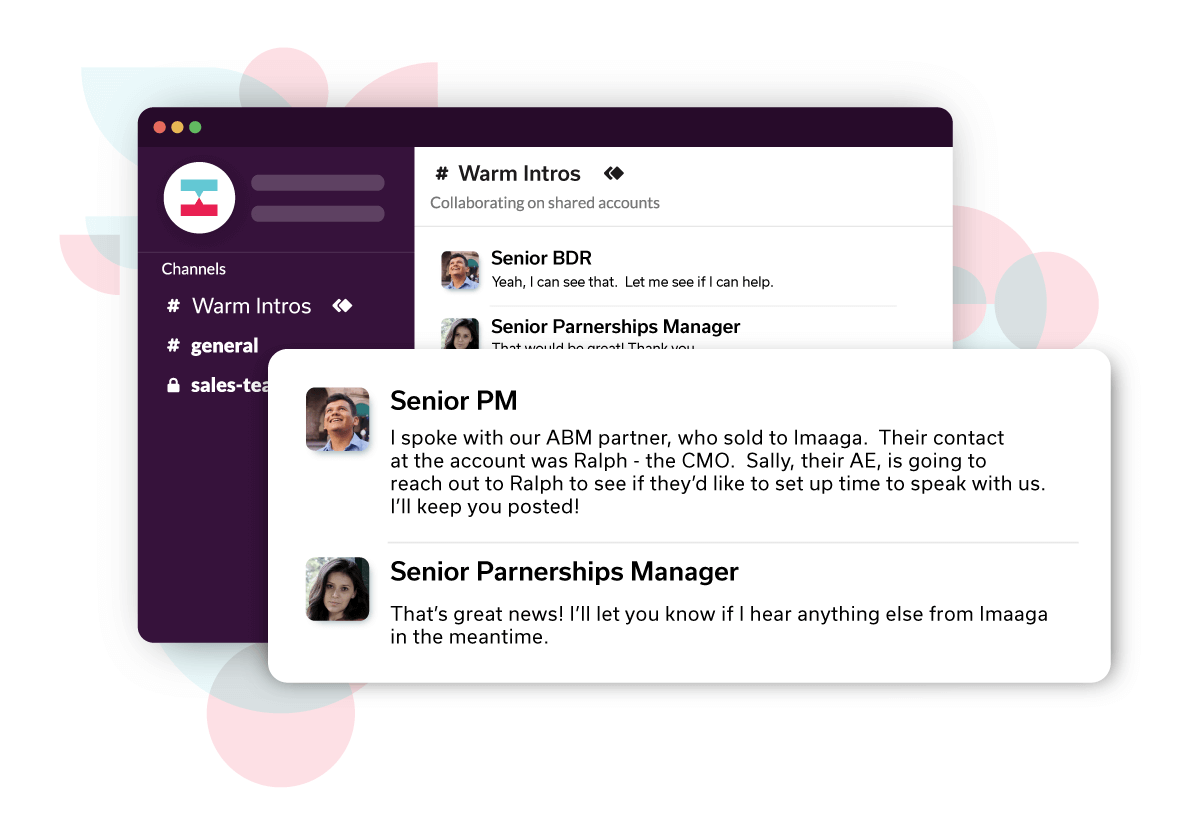Like mom always said, the best way to the heart of your sales team is a warm cup of soup — I mean, a warm intro. If your business development representative (BDR) has been trying to break into the same account for months, your partner can be your BDR’s saving grace. Your partner can give them critical information to advance the account through each stage of the sales cycle.
The partnerships team at Ometria, a customer data and marketing platform (CDMP) for retail, has seen a single act of kindness — ahem, an act of partner influence — incite a multiplier effect of excitement among their sales team.
It wasn’t a super-complicated process that ended in a light show. It was a simple, collaborative effort between a Senior BDR and a Senior Partnerships Manager (PM).
It went like this:
On Monday morning, the Senior BDR mentioned an account they were struggling with. That same day, the partnerships manager reached out to the partner to see if they could help.
On Monday afternoon, the Senior BDR, Senior Partnerships Manager, and the partner’s CSM had a meeting to discuss how the partner’s CSM could help.
On Wednesday, the partner’s CSM included Ometria as the recommended customer data and marketing platform (CDMP) and integration for the customer during their customer kick-off meeting.
“When that happens, it paints a great picture for the rest of the sales team, they get it, we’re there to help them. We’re not competing.” says John McBriarty, Senior Partnerships Manager EMEA.
Below, you’ll learn how Ometria’s partnerships team sets their sales team up for success.
#1 Ask Your BDRs for a List of Accounts They Need Help With
Quarterly, Ometria’s BDRs create a list of the top accounts they’re working on. Then, the partnerships team uses Crossbeam to identify which of the accounts their partners could help influence.
If the prospect accounts overlap with their partner’s “customers” list, Ometria’s partnerships team might ask for a warm intro or for information about top stakeholders in the account.
The account mapping matrix in Crossbeam
Then, the BDRs and PMs discuss the status of each of the accounts via Slack. They also host regular meetings to discuss the status of their accounts and where a partner could assist.
To increase partner engagement for your own sales team, start by working with your BDRs directly or with their manager to gather a list of accounts each BDR needs assistance with. Perhaps your BDRs are having trouble getting a call on the books, or maybe they need to know which stakeholder has the most buying power and when the right time is to reach out.
When gathering information from your BDRs, decide:
- How often should my BDRs and I meet to discuss the accounts they need help with?
- How will they share the information with me — via Slack, in recurring meetings?
- Which types of accounts should we prioritize? Accounts who fit into a particular partner tier or category, or accounts existing in a particular stage of the sales cycle?
- Should I get in touch with the partner or their AE/CSM on behalf of my BDR? Or will my BDR reach out to the partner?
#2 Identify Partners Who Could Help With the Accounts
The partnerships team at Ometria runs a report in Crossbeam or in Salesforce (via the Crossbeam Salesforce App) revealing which of the selected accounts overlap with their partners.
Ometria’s team utilizes Crossbeam’s Salesforce App, which enables their BDRs and AEs to view partner data directly in Salesforce. They also use Crossbeam’s Chrome Extension, which allows their BDRs to view partner data while prospecting.
“We have a nifty little widget that sits on the right-hand side that has the Crossbeam [partner data]. Whenever a salesperson has an account, they can see it’s a customer of our partners. ‘Let’s go and see if X partner can provide intelligence for us,’” says Allison Wagner, Senior Partnerships Manager at Ometria.
“It’s now that I can go back to our AE and say, ‘You’ve outlined these accounts. I’ve come back with a list of X accounts where we’ve identified partners,’” says Wagner.
You could also set alerts in your customer relationship management (CRM) system to identify accounts that have remained in a particular stage of the sales cycle for X days. Then, identify which partners could help move those accounts from that particular sales cycle to the next.
When identifying which partners can help, you should:
- Determine how the particular partners could help (e.g. if the account is a customer of the partner, maybe they can make an intro for your BDR).
- Determine which partners have the most potential influence (e.g. If partner A has a long-term relationship with the account and more engagement on a daily basis versus partner B, who has limited engagement with the account).
#3 Discuss Your Sales Rep’s Roadblock
The partnerships team at Ometria checks in with its BDRs and AEs to understand the interaction they’ve had with the account, if any, and their current pain points.
For example: McBriarty says one of their Senior BDRs had been trying to break into a particular account for a while.
“One of the BDR messages me and says, ‘[The prospect] is looking at my content, interacting with my emails, but they’re not responding to my meeting requests. I can’t get into the account. Can you help me?’” says McBriarty.
When McBriarty reached out to his partner on behalf of the Senior BDR, he learned that his partner was onboarding the account as a new customer the following week. The partner immediately connected McBriarty and the Senior BDR with the partner’s CSM.
As a result of the meeting, the partner’s CSM included Ometria as a recommended CDMP and integration during their kickoff meeting with the customer.
When discussing your BDR and AE’s roadblocks, consider:
- What has the interaction been with the account thus far? Has the BDR or AE received any responses from the account stakeholder?
- Does the account currently use a competitor’s software as part of their tech stacks? Are they shopping around for software like yours? (You can use an intent data platform to get insights like this.)
- Are there any integration or joint solution use cases that might be appealing to the account?
#4 Reach Out to Your Partner
The partnerships team at Ometria then reaches out to their partner on behalf of the BDR or AE. If the account is a customer of their partner, the partnerships team will ask the partner if they would reach out to their customer on behalf of Ometria. Ometria will include an email snippet that the partner can use or modify for their outreach. If the partner agrees to reach out to the account and the account is interested in an intro, the partner will facilitate the intro.
Wagner includes the following in an email to her partner:
- A blurb the BDR writes explaining the current state of the account
- A draft of an email her partner’s CSM can send to the account to facilitate an intro
Then, the partnerships team will follow up with the BDR or AE to update them on the partner’s interaction with the account.
When reaching out to your partner, consider:
- How can you tailor your value proposition to resonate with the particular account? Consider including specific use cases and custom-tailored messaging in your outreach to the partner.
- How often have I been reaching out to this partner for support? Is this also an opportunity to ask how my team can help support my partner on specific accounts they’re trying to break into?
As your company grows, you could also consider adopting a role-based partner pairing approach. Role-based partner pairing entails matching your sales reps with a handful of sales reps from partners’ teams for regular co-selling syncs.
Additionally, you could enable AE tagging in Crossbeam to alert your sales reps whenever a new overlap is found. From there, they can reach out to your partner directly through the Crossbeam Slack App or via email.
#5 Set Up a Meeting (and Give Your Sales Rep the Floor)
In some cases, Ometria’s partnerships team sets up a meeting between a Senior PM, their BDR or AE, and the partner’s AE or CSM.
For example: In the meeting McBriarty set up between himself, his Senior BDR, and his partner’s CSM, McBriarty encouraged his Senior BDR to ask all of the questions he needed to to accelerate the sales cycle.
McBriarty says, “The CSM said, ‘Yeah, what do you guys need to know? I know Ometria is a great partner, our partners have said great things. We’ve got an existing integration, what do you need?’”
He adds, “I’m in the meeting, and the Senior BDR was in heaven. It’s like, ‘Alright, we know what their tech stack is, these are the contacts I’m working with now, what projects are they working on? Am I missing anything?’”
“The Senior BDR that saw this, I think he went straight back to his boss and said, ‘I just came off the most amazing intro call with a partner,’” says McBriarty. “And after that I’ve had four BDRs messaging me about their prospects saying, ‘Can we do the same thing?’”
Make sure to provide relevant enablement resources to your BDRs and AEs so they’re familiar with your partner and your integration before getting on a call.
If your sales rep meets with your partner’s CSM on their own, make sure they know the right questions to ask. Including:
- What are you working on with your customer right now? What are you working towards?
- What should I know upfront before my call with your customer?
- Who are the stakeholders I should be speaking with from the account?
#6 Provide Your BDR With Next Steps
Your partner has helped out your BDR or AE. Now what?
Ometria’s SDRs and AEs typically schedule a follow-up call with their Senior PMs to update them on the status of their accounts and discuss additional options to accelerate the deal with the partner’s support.
Consider the following when establishing next steps with your team:
- When and how often should your sales rep reach out to your partner’s CSM or sales rep?
- Should your BDR or AE update you when they get their first call with the account on the books? After the call? When the deal closes?
- How can you make sure you’re supporting your partner in the same way they’re supporting your sales team?
—
Want to host a movie night with your closest partnerships friends — or simply to watch each of the recordings on your own? Sign up for our newsletter below to get the recordings of every talk from Supernode 2022.











This is a test comment.
This is a longer test comment to see how this looks if the person decides to ramble a bit. So they're rambling and rambling and then they even lorem ipsum.